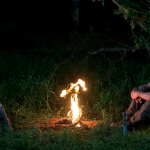I recall my childhood Saturday mornings with great fondness: waking up at 7:00 a.m. and watching cartoons well into the afternoon. My favorites were G.I. Joe, Transformers, Thundercats, and Danger Mouse. But above them all was The Teenage Mutant Ninja Turtles. The four wildly immature, yet skillfully trained, ninjas were my obsession. I had a trunk full of toys, posters, t-shirts, and costumes. So naturally when I saw that there had been a resurgence in “Turtle love” I was excited! My nephew has already taken to calling himself Raphael for months, and a new cartoon has been airing since 2003. But there was something strange about these new Turtles that it took me some time to put my finger on. This morning as my two year old daughter caught a few minutes of one of the shows it hit me. The new turtles are far darker than the old!
Some will quickly point out that cartoons have often displayed some graphic and “dark” imagery. In this particular episode we see a dry-boned Shredder reconstituting his muscles, sinews, tissue, and skin. It was a rather graphic image, I thought, for a simple children’s cartoon. The old Ninja turtles had a disembodied brain, but he was goofy looking, humorous, lovable. But this new Shredder was gruesome to look at. This is, I observed, a common trend in today’s children’s cartoons.
This observation on my part has raised a question in my mind: when am I observing a serious trend and when am I simply nostalgic. It is common for us to look back on the past with unrealistic idealism. Israel did this in the Wilderness when they spoke of Egypt as a place with plenty of food and shelter, ignoring the obvious fact that they were slaves. We always tend to think our past was better than it really was, that our shows were more wholesome, that our movies more pure, that our characters more honest. But “dark” is often subjective. So maybe Shredder is darker in comparison to my old Shred-head, but that doesn’t necessarily make him immoral, impure, or unwholesome for kids today. We each need to be careful about making the standard our own subjective memories.











